Present
- • Brands’ responsibility to be more sustainable
-
Brands have been quick to answer the rising demand for cheaper clothing - but at what cost? The 2013 collapse of the Rana Plaza
 (BBC News, 2015) building in Bangladesh was a tragedy that cost 1,134 lives – many of whom were garment production staff, ordered to come to work despite warnings about the building’s safety. This event was an eye-opener for the public, exposing a side to fashion that often goes unseen.
(BBC News, 2015) building in Bangladesh was a tragedy that cost 1,134 lives – many of whom were garment production staff, ordered to come to work despite warnings about the building’s safety. This event was an eye-opener for the public, exposing a side to fashion that often goes unseen.
“The workers of Rana Plaza had already pointed out the cracks in the building to management and had said it was unstable.”(The True Cost, 2015)
Every year, millions of shoppers frequent the big high street retailers looking for the best deals and style trends. This movement has increased dramatically over the last 20 years, becoming known as ‘fast fashion’. Sure, this rapid interchange of supply and demand has propelled numerous brands into the billion-figure sector – but is this business model really sustainable? And, well… moral?
The documentary ‘The True Cost’ aims to uncover the hidden truths of fast fashion, and help consumers think more carefully about what goes into their shopping bags. Los-Angeles based filmmaker Andrew Morgan hopes to reveal how the perfectly glamorous world of fashion engineering “…feels like a perfectly engineered nightmare for the workers trapped inside”(The True Cost, 2015)
Is it possible for high street fashion brands to be successful and support the millions of factory workers they rely on?
Fashion Revolution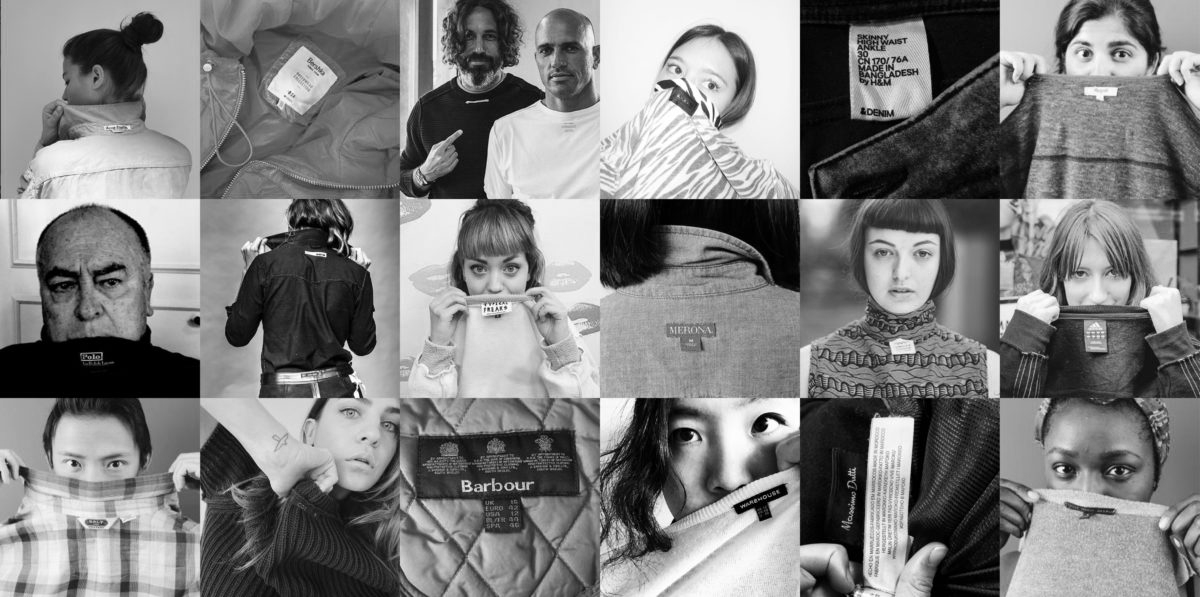 are a social enterprise founded to fight for greater transparency in the industry, and to ensure safer working conditions for garment workers. Each year they release the annual Fashion Transparency Index - a list evaluating 150 of the biggest fashion brands (including Calvin Klein, Gucci, and Louis Vuitton) across five key areas. Policy & Commitments, Governance, Traceability, ‘Know, Show & Fix’ and Spotlight Issues headline the reviews on what brands disclose about their suppliers, supply chain policies and practices, and social and environmental impact.
are a social enterprise founded to fight for greater transparency in the industry, and to ensure safer working conditions for garment workers. Each year they release the annual Fashion Transparency Index - a list evaluating 150 of the biggest fashion brands (including Calvin Klein, Gucci, and Louis Vuitton) across five key areas. Policy & Commitments, Governance, Traceability, ‘Know, Show & Fix’ and Spotlight Issues headline the reviews on what brands disclose about their suppliers, supply chain policies and practices, and social and environmental impact.
According to the 2018 Fashion Transparency Index brands had an average of 21 per cent Fashion Transparency– an increase of only one per cent since 2017. With no brands scoring more than 60 per cent, there is still a lot of progress to be made. There is a particular lack of transparency around the treatment of garment workers, often women. With some brands also refusing to disclose any information whatsoever on this subject, it’s difficult to get an idea of the whole picture. (Dazed, 2018)
Nevertheless, the story is not all bleak. Hope can be seen in the activism of some brands, that demonstrate standards we’d like to see more of in a future of ethical fashion. Activewear brand Patagonia sport the mission statement:
sport the mission statement:
‘Build the best product, cause no unnecessary harm, use business to inspire and implement solutions to the environmental crisis’
Their website is worth a look. It offers a refreshing, powerful and positive view of how to be responsible and sustainable in the world of fashion. - • The harsh reality of your wardrobe
-
How much do you make the most of all the clothes in your wardrobe? Ever find yourself feeling like there is still nothing to wear?
We’re all guilty of buying clothes we want more than we really need. Typically, these items get worn once or twice, and then hang about attracting moths for a few years. The thought “I’m sure I’ll wear it again one day” is familiar for many of us. According to the 2015 documentary ‘The Next Black’ , 30 billion pounds worth of clothing in the UK hasn't been worn once in the last year. Add in a comparison here, eg. £30,000,000,000 – that’s enough to eradicate a life-threatening disease. Do we need to buy less, and care more?
, 30 billion pounds worth of clothing in the UK hasn't been worn once in the last year. Add in a comparison here, eg. £30,000,000,000 – that’s enough to eradicate a life-threatening disease. Do we need to buy less, and care more?
Each year huge quantities of clothes are thrown out as consumers re-style their wardrobes season after season. The Waste and Resources Action Programme (WRAP) estimates that we purchased 1.13m tonnes of new clothing in 2016 in the UK (Siegle, 2017). And this is only new clothing – it’s no surprise Ikea’s three-door wardrobes are more popular than ever before.
“Buy less. Choose well. Make it last.” – Vivienne Westwood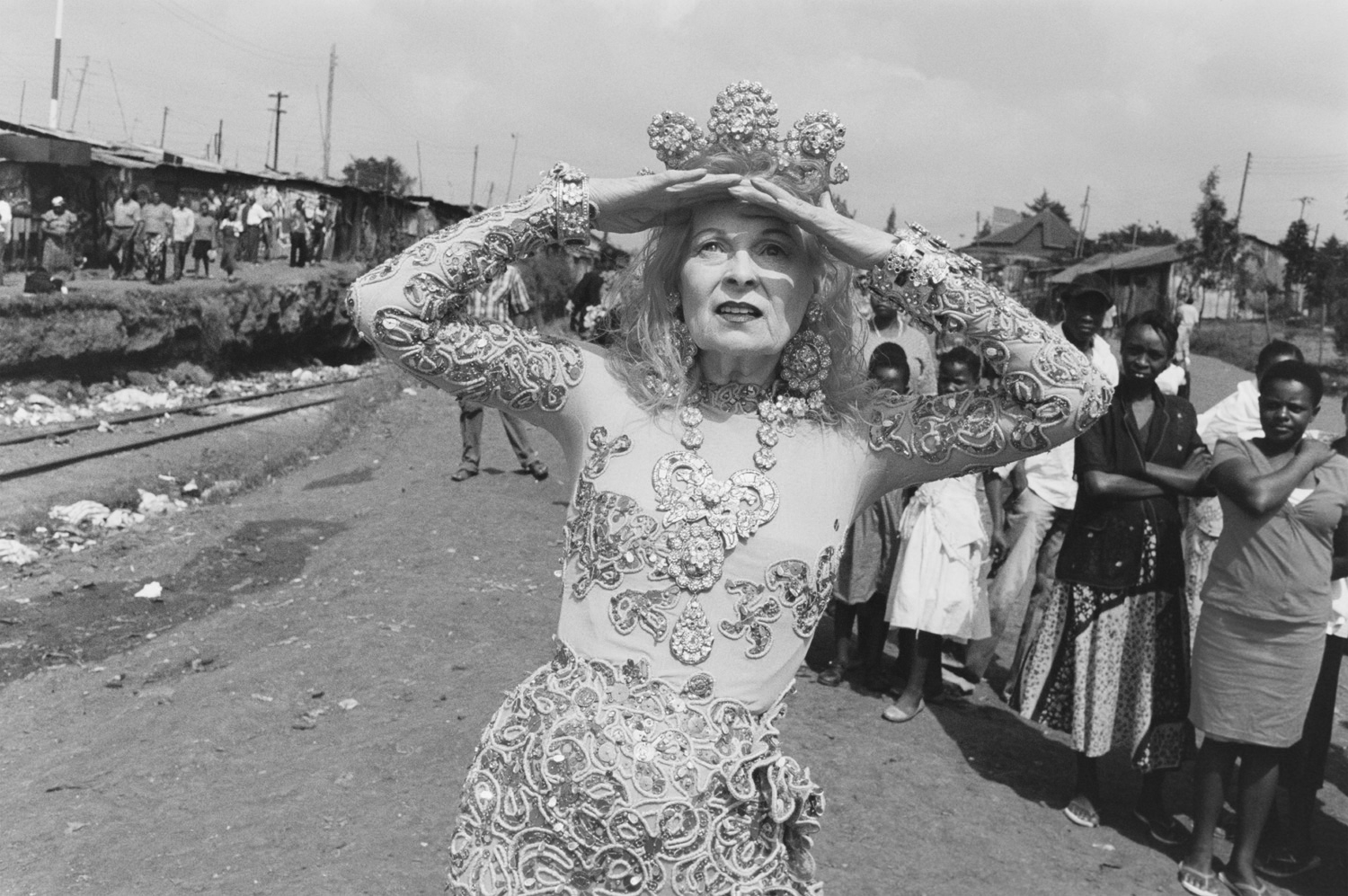 (BBC, 2017)
(BBC, 2017)
Okay, so we may be a bit wasteful when it comes to our fashion indulgences. But it’s not exactly causing any harm, right? Wrong. Our passion for fast fashion drives human labour, animal cruelty, increases water pollution, adds to the use of toxic chemicals, and generally has an all-round negative impact on the environment. (Perry, 2018)
A recent report from the Ellen MacArthur Foundation warned:
“If the fashion industry continues on its current path, by 2050, it could use more than 26 percent of the carbon budget associated with a 2C pathway.”(Laville, 2018) In layman’s terms, this means that fashion alone could leapfrog us uncomfortably closer to the threshold for dangerous global warming. And a good supply of swimwear and fur coats won’t be the end of that predicament.
Here’s the good news – if you’re reading this article, you’ve already got your foot on the ladder to change. What we need is a movement to put some speed bumps on this runway. Slowing down a little might help us to think about what new clothes we buy, and how we could put the stuff we don’t need any more to good use. - • From street to screen – can we make it green?
-
Nowadays, when we feel the urge to buy new clothing, it can seem a whole lot easier to pick up a smartphone or laptop than to trail through a busy shopping centre. In fact, we might not realise we want something until it catches our attention while we’re online (ahem) doing other important things. But what impact does the shift to an online market have on the wider fashion industry?
Close to 7 in 10 (67%) of women in the UK have bought clothes online in the last 12 months (Mintel 2017).
One issue is that less in-store purchases and more online demand encourages fashion retailers to make drastic changes to their business models – but not everyone can keep up. Data suggests that almost one in five high street fashion retailers are already showing early warning signs of becoming insolvent (Willmont, 2018) and the industry is set to face increasing turbulence over the coming months. (Euromonitor, 2016)
This all ties in with the overarching problem – sustainability. As fashion increasingly moves off the high street and onto our computer screens, consumers give less thought to how much they really need something before purchasing. Is there a way to prevent our ‘click-to-buy’ fashion culture from fuelling core ecological concerns such as animal cruelty, human labour and pollution?
Well, one way is to make the online market more sustainable. For example, Asos have started an ‘eco edit’ and in August this year, Central Saint Martin is hosting a course titled ‘Promoting Sustainability in Fashion (Online). The Guardian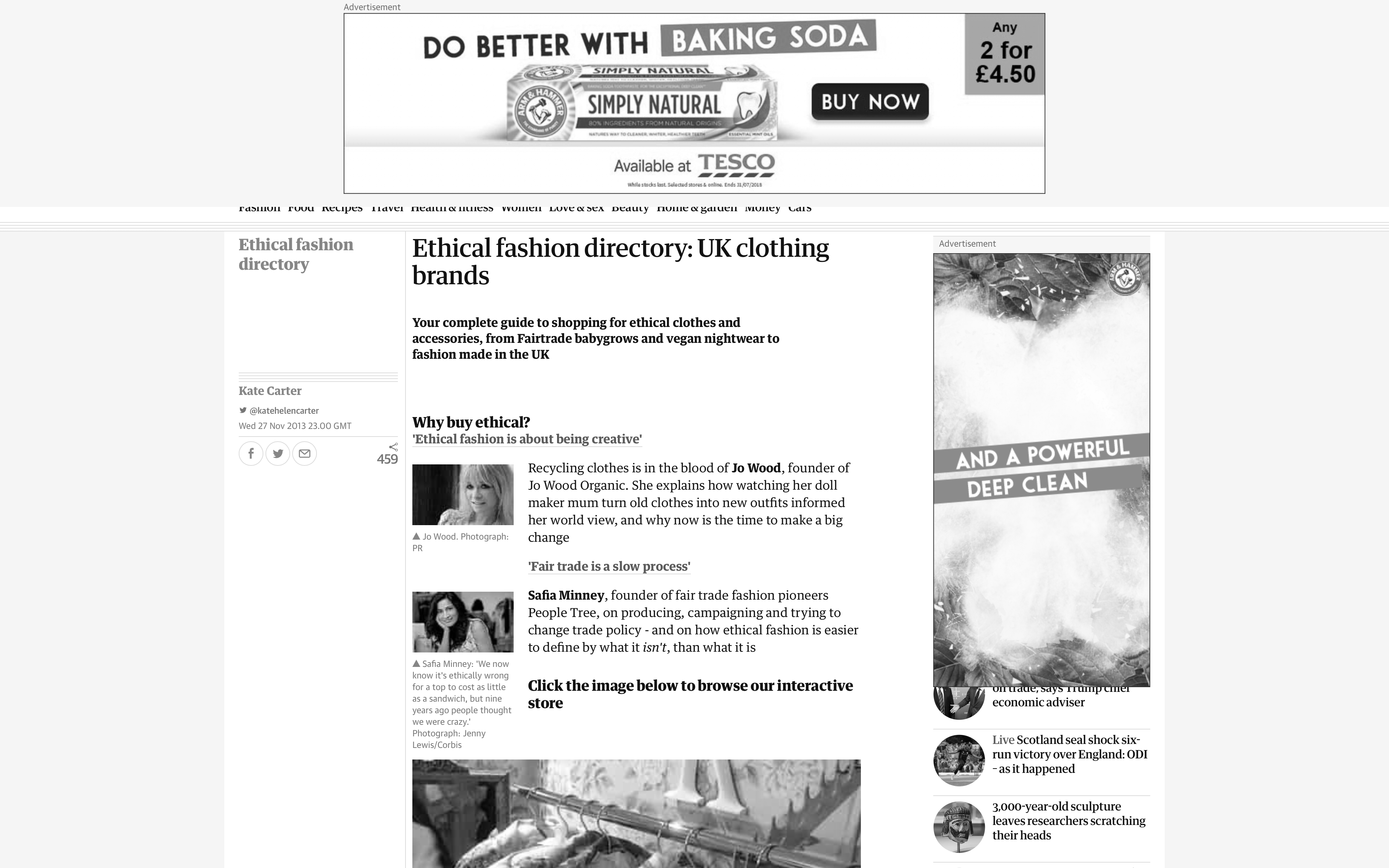 has published an online ethical fashion directory, giving a complete guide to shopping for ethical clothes and accessories. From Fairtrade baby grows and vegan nightwear to fashion made in the UK (therefore cutting import costs), they are flagging the way for a more sustainable fashion future, even with a fast-paced market.
has published an online ethical fashion directory, giving a complete guide to shopping for ethical clothes and accessories. From Fairtrade baby grows and vegan nightwear to fashion made in the UK (therefore cutting import costs), they are flagging the way for a more sustainable fashion future, even with a fast-paced market.
Leading names in the industry can also have an important impact in promoting sustainable fashion. Stella McCartney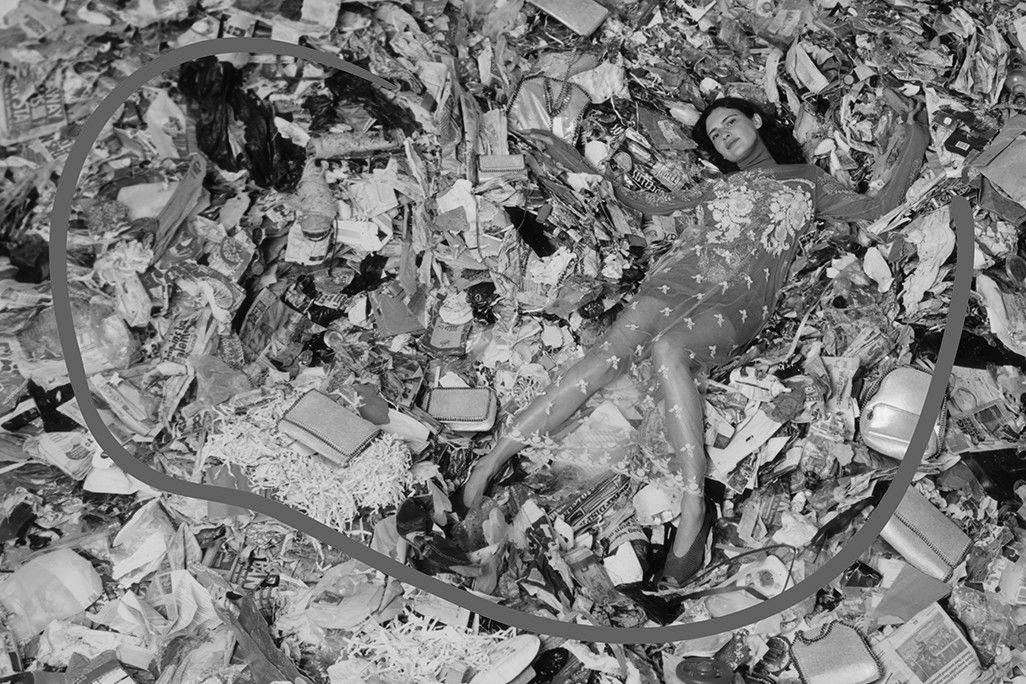 is a pioneer in this field; since launching her ‘Ready-to-Wear’ collection, she has refused to work with leather, fur or feather, and even her cashmere is regenerated. Livia Firth, who launched Eco Age in 2009, encourages celebrities to wear ethical designs at high profile events (including the Oscars) through her Green Carpet Challenge initiative. She believes that efforts to curtail the negative impact of fast fashion have to meet consumers where they’re at – online. “We need to enrol all the bloggers and the Instagram powerhouses and turn them into actors of change.” (Craik, 2018)
is a pioneer in this field; since launching her ‘Ready-to-Wear’ collection, she has refused to work with leather, fur or feather, and even her cashmere is regenerated. Livia Firth, who launched Eco Age in 2009, encourages celebrities to wear ethical designs at high profile events (including the Oscars) through her Green Carpet Challenge initiative. She believes that efforts to curtail the negative impact of fast fashion have to meet consumers where they’re at – online. “We need to enrol all the bloggers and the Instagram powerhouses and turn them into actors of change.” (Craik, 2018)
Firth makes a great point. Fast fashion may well be fuelled by the rise of media use in the industry – but so can awareness of how to keep it sustainable. - • Bibliography
-
- • Images
-
Figures 1. BBC News (2015) Bangladesh murder trial over Rana Plaza factory collapse [fig.] BBC (Accessed: 22 May 2018)
Figures 2. Fashion Revolution (2018) IT'S TIME FOR A FASHION REVOLUTION [fig.] Fashion Revolution(Accessed: 22 May 2018)
Figures 3. Patagonia (2018) IT'S TIME FOR A FASHION REVOLUTION [fig.] Patagonia(Accessed: 22 May 2018)
Figures 4. AEG (2014) The Next Black [fig.] (Accessed: 22 May 2018)
Figure 5. Velvet tango elisa (2011) FASHION CAN SAVE THE WORLD [fig.] (Accessed: 22 May 2018)
Figure 6. Carter, Kate (2013) Ethical fashion directory: UK clothing brands [fig.] The Guardian (Accessed: 22 May 2018)
Figure 7. McCartney, Stella (2016) Discover the Winter 2017 campaign [fig.] Stella McCartney (Accessed: 22 May 2018)
- • Documentaries/Videos
-
The True Cost (2015) Directed by Andrew Morgan [Film] Los Angeles: Life Is My Movie Entertainment
- • Articles
-
Laville, Sandra (2017) Stella McCartney calls for overhaul of 'incredibly wasteful' fashion industry, The Guardian, 28 November 2017 Available: The Guardian (Accessed 14 May 2018)
Perry, Patsy (2018) THE ENVIRONMENTAL COSTS OF FAST FASHION, Indipendent, 8 January 2018 Available: Independent (Accessed 15 May 2018)
Siegle, Lucy (2017) Fashion must fight the scourge of dumped clothing clogging landfills, The Guardian, 8 January 2018 Available: The Guardian (Accessed 15 May 2018)
Craik, Luara (2018) Fashion must fight the scourge of dumped clothing clogging landfills, The Guardian, 8 January 2018 Available: The Guardian (Accessed 15 May 2018)
- • Report
-
Euromonitor (2016) Fashion Industry and The New Consumerism, euromonitor.com
Future
- • Biology meets Fashion
-
Fabrics have largely remained unchanged for hundreds of years. Could biology help bring a solution to lowering waste levels and enabling more sustainability in fashion?
Biology is a field you wouldn’t immediately associate with fashion but, with the rise in demand for cheaper and faster fashion, there is now more than ever a need for innovation that helps ensure a sustainable future for the industry.
Modern Meadow is a venture-backed biotech start-up that is at the front line of fabric innovation in fashion. They have developed an eco-friendly alternative to leather called ZOA™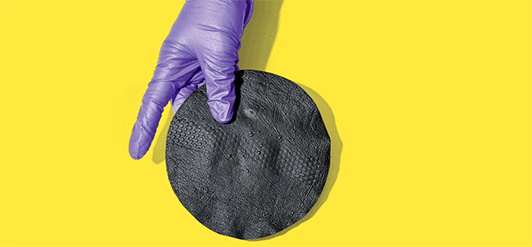 (Modern Meadow, 2018) that can be created in a lab – no animals necessary. Grown from animal-free collagen and combined with other materials, these versatile bioleathers truly "break the mould” - they can take on any textures and structures, solid or liquid.
(Modern Meadow, 2018) that can be created in a lab – no animals necessary. Grown from animal-free collagen and combined with other materials, these versatile bioleathers truly "break the mould” - they can take on any textures and structures, solid or liquid.
In a talk for Business of Fashion Voices 2017 , the founder of Modern Meadow, Andras Forgacs, spoke about his vision for the future: “We want to make what we love about leather and go beyond that... It will be dozens or hundreds of materials. It’s an operating system to create new materials.” (The Business of Fashion, 2018)
Bolt Threads is another company pioneering eco-conscious developments in the fabric industry. This startup, making spider silk from microbugs, has recently raised a giant $123 million in funding. (Buhr,2018)
In early May, the Design Museum hosted a workshop on bio-materials introducing the general public to this “growing culture” (get it?). Through handling sessions, presentations and group discussion, participants learned about the cutting-edge research and projects that are likely to change the world of fashion as we know it. (Design Museum, 2018)
With the ball already rolling, it looks like this is the kind of education needed by the fashion students of tomorrow... - • Smart stuff: You and your clothes
-
Technology has already changed the world of fashion dramatically over recent years – virtualized mock-ups, wearable tech and artificial intelligence. With an ever-pressing desire for personalisation in the industry, will Silicon Valley have the answers?
For centuries, fashion has been used by the masses as an outlet for personal expression, social code and identity. (The Next Black, 2014) In modern society, customers increasingly want to create their own styles – while borrowing from current trends - and have the freedom to adapt as it suits them. But the fundamental concept of clothing has remained constant – they are materials which (mostly) cover bodies, manufactured with a (mostly) standard set of procedures. But developments in technology such as Augmented Reality (AR) and Artificial Intelligence (AI) may be set to change all of this.
“From product development to distribution, nothing about the fashion supply-chain is agile.”
(C. Close,2017) Science fiction has often pictured a future where our wardrobes are computer-operated, and we can swap our outfits digitally as shown in the film Clueless. (TEDx Talks, 2016) However, this future seemed pretty far off – until the arrival of AR. Although fashion hasn’t embraced the technology to its full potential, brands like Zara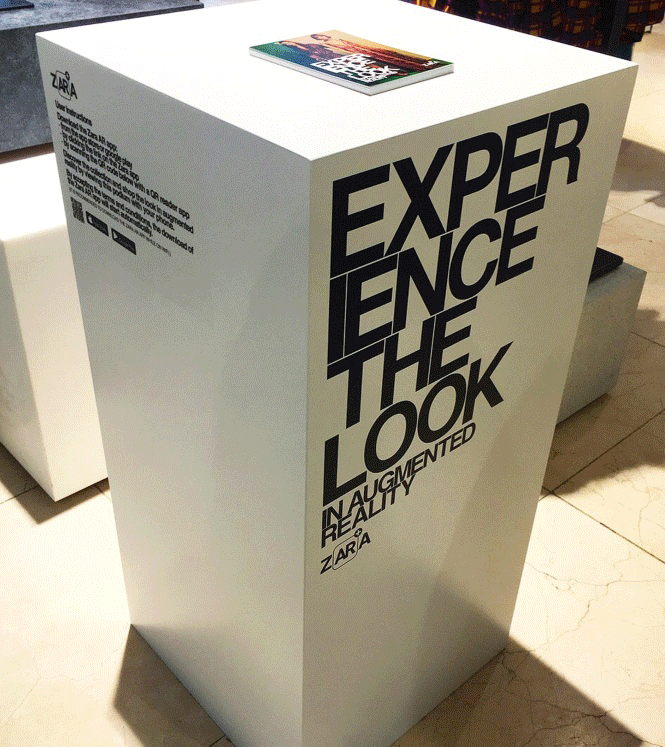 have started bringing it to their stores to help entice customers into purchasing. (KÖLLINGER, 2018) Current research estimates that the AR market is worth $3.48 billion (USD), and will grow to over fifty times this in the next seven years - to $ 198.17 billion by 2025 (McCoin, 2018). We cannot deny the impact these changes are going to have on all areas of our lives, and fashion is no exception.
have started bringing it to their stores to help entice customers into purchasing. (KÖLLINGER, 2018) Current research estimates that the AR market is worth $3.48 billion (USD), and will grow to over fifty times this in the next seven years - to $ 198.17 billion by 2025 (McCoin, 2018). We cannot deny the impact these changes are going to have on all areas of our lives, and fashion is no exception.
This year, Ikea has demonstrated how AR can assist personalisation in interior design, through their mobile app ‘Place’ (Pardes, 2017). It allows customers to visualise furniture, to scale, in their own homes – before making a purchase. Our guess is that it is only a matter of time before fashion retailers consider similar approaches to enhancing our online clothes shopping experiences.
In the buzzing field of AI, researchers have been working on a way for computers to learn about an individual’s fashion tastes, and create computer-generated images to match their style. One project at the University of California used algorithms, based on data gleaned from online clothing sites, to pinpoint and classify the user’s preferences for particular items. They then used Generative Artificial Intelligence (GAN) to come up with realistic images of the kinds of outfits these users might like to wear. With this kind of AI, online retailers could quickly detect or define emerging fashion trends – something Amazon has already clocked, with their AI Fashion designer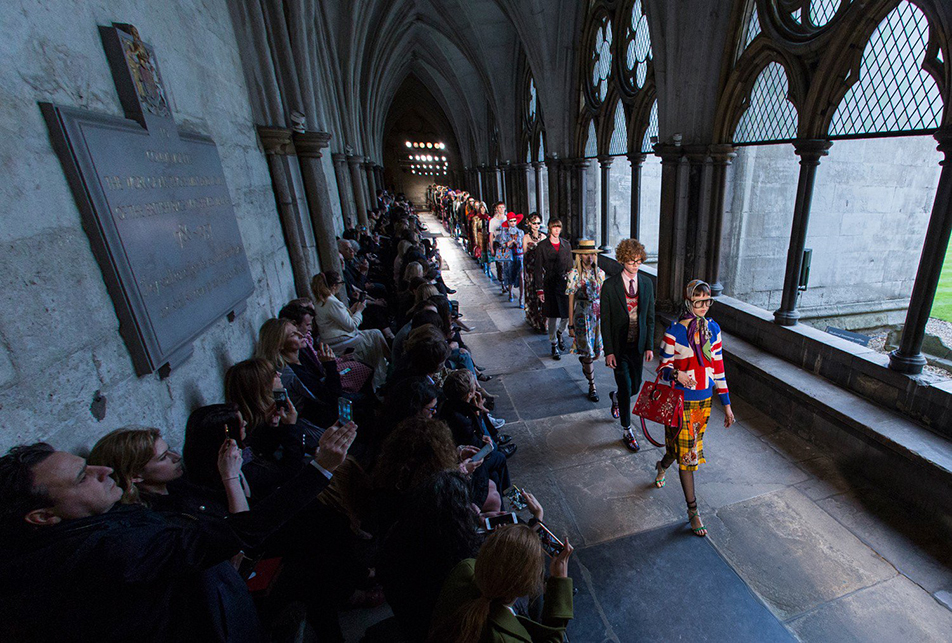 (Knight,2017). And they’re not alone - Alibaba has just launched FashionAI, a technology which recommends items to shoppers, based on what they brought into the changing room (Jackie Snow, November 2017)
(Knight,2017). And they’re not alone - Alibaba has just launched FashionAI, a technology which recommends items to shoppers, based on what they brought into the changing room (Jackie Snow, November 2017)
And it’s not just the hope of personal gain that is offered by technologies such as AR and AI. On average, people wear about 20% of their wardrobes, but it doesn’t have to be like this. Improving the chances of us buying clothes we will really wear, and helping us to recycle those we won’t, can all help the movement towards more sustainable fashion. Now that’s à la mode. - • Dresses hot off the presses
-
3D-printed fashion has been on the runway since 2010, with Dutch designer Iris Van Herpen
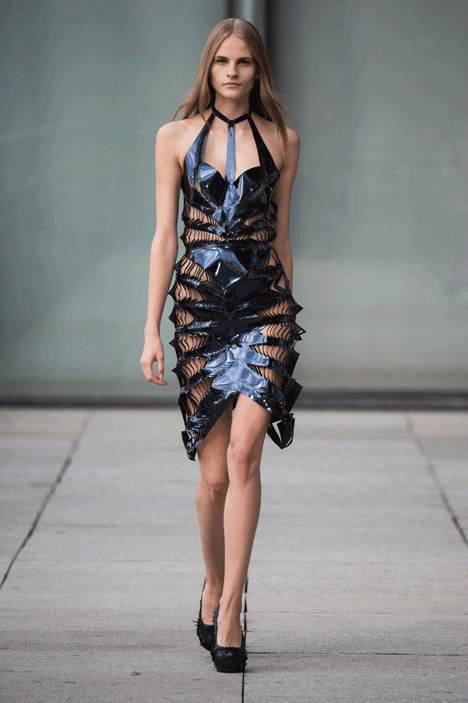 being one of the first big names in this hi-tech movement. The early days saw mostly white, nylon, skeleton-like structures, but developing technology means we are beginning to see more multi-colour, multi-material designs. Is this just a folly, or is there a future for such futuristic fashion?s
being one of the first big names in this hi-tech movement. The early days saw mostly white, nylon, skeleton-like structures, but developing technology means we are beginning to see more multi-colour, multi-material designs. Is this just a folly, or is there a future for such futuristic fashion?s
Technology today is bringing innovative approaches to making garments. Microsoft and the London College of Fashion have recently partnered to bring great student minds together in exploring forward-thinking solutions for the industry’s future. On a one-semester program, students will have access to the latest technologies such as Artificial Intelligence, Mixed Reality and 3D printing, and will be helped by leading experts to develop their ideas into prototypes. (Microsoft, 2018)
have recently partnered to bring great student minds together in exploring forward-thinking solutions for the industry’s future. On a one-semester program, students will have access to the latest technologies such as Artificial Intelligence, Mixed Reality and 3D printing, and will be helped by leading experts to develop their ideas into prototypes. (Microsoft, 2018)
Currently, it takes a long time to produce a 3D dress – anything up to 500 hours – and that doesn’t include the ‘make up’ of the various pieces. (Jacobson, 2017) Furthermore, the 3D printed materials are still quite rigid in texture. It’s not an issue with jewellery and accessories, but dresses aren’t quite comfortable to sit down in yet. Nevertheless, designers are working on it, playing with an algorithm that stimulates cell division, and producing an interlocking weave. It sounds technical enough.
There has been more commercial success in footwear. Both Nike (Nike, 2018) and Adidas
(Nike, 2018) and Adidas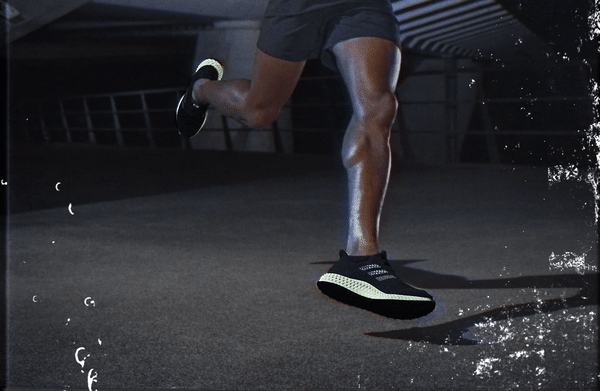 are already using 3D printing to create high performance padding and shoe soles.
are already using 3D printing to create high performance padding and shoe soles.
Does this mean there might be a time where we could print our own clothes, at home? We may be a while away from this, but the idea is not totally out there. Israeli fashion designer Danit Peleg, who has used 3D in her collections since 2015, used home printers to print her entire graduation collection – without knowing anything about the technology before she began.
One down-side of 3D-printed fashion is the use of plastic in garments – but the ecologically-minded voices in the fashion world have already raised this argument. Alongside improving the comfort of printed garments, finding ways to print with sustainable materials should be high on our priority list. But, in the present era of developing technology, very little is impossible. - • Bibliography
-
- • Images
-
Figure 1. Modern Meadow (2015) This is Zoa™. The world’s first bioleather materials brand. [fig.] Modern Meadow (Accessed: 18 May 2018)
Figure 2. The Business of Fahion (2018) Welcome to the Era of Biofabrication | Andras Forgacs | #BoFVOICES 2017 [fig.] The Business of Fashion (Accessed: 18 May 2018)
Figure 3. BDA LDN (2018) London Retail: Zara AR [fig.] BDA LDN (Accessed: 20 May 2018)
Figure 4. Knight, Will (2017) Amazon Has Developed an AI Fashion Designer [fig.] MIT Technology Review (Accessed: 22 May 2018)
Figure 5. Howarth, Dan (2014) Iris van Herpen uses 3D printing and magnets to form Spring Summer 2015 fashion collection [fig.] Dezeen (Accessed: 26 May 2018)
Figure 6. Microsoft (2018) London College of Fashion: Incubating the future of fashion [fig.] Microsoft (Accessed: 1 June 2018)
Figure 7. Nike (2018) WHAT IS NIKE FLYPRINT? [fig.] Nike (Accessed: 16 May 2018)
Figure 8. Adidas (2018) Futurecraft.4d [fig.] Adidas (Accessed: 16 May 2018)
- • Documentaries/Videos
-
TEDx Talks (2016) Fashion and Technology: From Frivolity To Sustainability | Rachel Arthur | TEDxCoventGardenWomen, Available at: YouTube (Accessed: 10 May 2018)
The Business of Fashion (2018) Welcome to the Era of Biofabrication | Andras Forgacs | #BoFVOICES 2017, Available at: YouTube (Accessed: 10 May 2018)
The Next Black (2014) Directed by David Dworsky and Victor Köhler [Film] Stockholm: House of Radon
- • Articles
-
Buhr, Sarah (2018) Spider silk startup Bolt Threads closes on $123 million in Series D funding, 3 January 2018 Available: TechCrunch (Accessed 15 May 2018)
C. Close, Marc (2017) ‘Op-Ed | Technology Is Eating Fashion', Business of Fashion, 31 August 2017 Available: Business of Fashion (Accessed 20 May 2018)
Design Museum (2018) Growing Cultures: An Introduction to Bio-Materials, Available: Design Museum (Accessed 20 May 2018)
Knight, Will (2017) Amazon Has Developed an AI Fashion Designer, 24 August 2017 Available: MIT Technology Review (Accessed 25 May 2018)
Jacobson, Roni (2017) THE SHATTERING TRUTH OF 3D-PRINTED CLOTHING, Wired, 5 December 2017 Available: Wired (Accessed 16 May 2018)
KÖLLINGER, SONJA (2018) Zara Is Changing How We Shop Through Augmented Reality, 14 April 2018 Available: refinery29 (Accessed 25 May 2018)
McCoin, James (2018) BIS Research report on the growth of the market VR, AR and MR, 8 April 2018 Available: Medium (Accessed 16 May 2018)
Modern Meadow (2018) Leather re-imagined. Available: Modern Meadow (Accessed 16 May 2018)
Microsoft (2018) London College of Fashion: Incubating the future of fashion Available: Microsoft (Accessed 16 May 2018)
Nike (2018) WHAT IS NIKE FLYPRINT? Available: Nike (Accessed 16 May 2018)
Pardes, Arielle (2017) IKEA'S NEW APP FLAUNTS WHAT YOU'LL LOVE MOST ABOUT AR, Wired, 20 September 2017 Available: Wired (Accessed 16 May 2018)